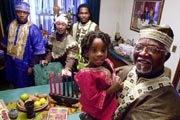


Kwanzaa a time for reflection
African-American
celebration encourages fellowship, commitment
By Shauna Scott Rhone
The Cincinnati Enquirer
12/26/2001
Thirty-five years ago, a California activist now known as
Dr. Maulana Karenga searched for a unifying solution to help his community heal
after the 1965 Los Angeles riots.
Dr. Karenga created Kwanzaa in 1966, in hopes of strengthening
family ties and community cooperation among African-Americans. Using African
symbols and the Kiswahili language, he shaped a cultural holiday to remind
participants of the contributions of people with African heritage living around
the world.
Spread over the seven days between the day after Christmas and New
Year's Day, each night of Kwanzaa was dedicated to discussing Kwanzaa's seven
principles (called Nguzo Saba). The principles were derived from Kawaida, the
philosophy of African thought and practice. They highlight subjects such as
cooperative economics, creativity, self-determination and faith.
This year's racial unrest in Cincinnati underscores why Kwanzaa
still is relevant 35 years after its creation, experts say.
“The five major activities of Kwanzaa are even more important to
practice at this time for Cincinnati,” says Tulivu Jadi, assistant director of
the Los Angeles-based African American Cultural Center. Dr. Karenga is the
center's director.
“First, it's a time for an in-gathering of the people, for them
to come together,” he says. “Especially to be in touch with people you haven't
been in touch with to reinforce those bonds.”
Kwanzaa is a time to show reverence for the natural resources and
preserving the Earth, he says. It also is a time to honor the past, “for those
on whose shoulders we stand. Focus on those in our personal past who impacted
our lives.”
People need to recommit themselves to the highest ideals, the
ethical values of African-American culture, he says.
“This is an opportunity to celebrate how far we have come and the
positive things done during the year. Celebrating the good in our lives makes
it possible to see the best in the bleakest of times,” Mr. Jadi says.
Several organizations in the Tristate hold Kwanzaa celebrations.
More than 300 people attended the City-wide Kwanzaa Committee's celebration
last year, according to chairman Curt Standifer. That attendance number was
down from previous years as more neighborhoods have begun to sponsor their own
gatherings. Mr. Standifer thinks the intimate settings are better for families
to learn more about the principles.
“I encourage families to celebrate,” he says. “We have our
celebration on the first night, but it's better to celebrate it in small groups
each remaining night in its entirety.”
Mr. Standifer suggests participants ask themselves and each other
their personal views of the day's principle, whether they follow it in their
lives and what positive effect it has for them and for others. He encourages
participation by all generations, especially children.
Faith Patterson of Yellow Springs has celebrated Kwanzaa in her
home for much of its 35 years. Mrs. Patterson, president of the African
American Cross-Cultural Works, is looking forward to this year's event, one her
organization sponsors.
“I've been involved with Kwanzaa for a long time,” she says.
“I've been interested in seeing this evolve because AACW's mission is to study
cultures all over the world.”
While she encourages others to learn about those cultures, she stops
short of identifying Kwanzaa as an intercultural event.
“Kwanzaa is about me,” says Ms. Patterson. “It's about my people.
My effort is to teach everyone about Kwanzaa and to work at keeping our legacy alive.
I'm happy for others to share in our legacy” while allowing for private
celebrations at home with close friends and family.
“Kwanzaa is a reason to get together, to fellowship,” says Mr.
Standifer. “Include children in the discussion to make Kwanzaa become clear in
its importance. Kwanzaa's purpose has duality. It was born based on the
struggles we have to wage every day. It encourages us to look at our African
history and culture. Looking at the past is the only thing that determines what
our future will be.”
Principles of Kwanzaa
The Nguzo Saba (seven principles) of Kwanzaa:
Umoja (Unity)
To strive for and maintain unity in the family, community, nation
and race.
Kujichagulia (Self-Determination)
To define ourselves, name ourselves, create for ourselves and
speak for ourselves.
Ujima (Collective Work and Responsibility)
To build and maintain our community together and make our
brothers' and sisters' problems our problems and to solve them together.
Ujamaa (Cooperative Economics)
To build and maintain our own stores, shops and other businesses
and to profit from them together.
Nia (Purpose)
To make our collective vocation the building and developing of
our community in order to restore our people to their traditional greatness.
Kuumba (Creativity)
To do always as much as we can, in the way we can, in order to
leave our community more beautiful and beneficial than we inherited it.
Imani (Faith)
To believe with all our heart in our people, our parents, our
teachers, our leaders and the righteousness and victory of our struggle.
Source: The Official Kwanzaa Web site (www.officialkwanzaawebsite.org)
Kwanzaa celebrates pursuit of
principles
By Kevin Aldridge
The Cincinnati Enquirer
12/26/2001
Beginning today, millions of people worldwide, mostly
African-Americans, will light a candle each day for a week.
 Preparing to celebrate
Kwanzaa are (from left) Deandre White, Rita Nzinga-Burgin, Terrence
Clinkscales, Kwasi Burgin, and Albert Burgin.
Preparing to celebrate
Kwanzaa are (from left) Deandre White, Rita Nzinga-Burgin, Terrence
Clinkscales, Kwasi Burgin, and Albert Burgin.(Steven M. Herppich photo) | |
They will be observing Kwanzaa, a celebration of African ancestry
and communion that calls on each person and the community to commit to seven
principles, building blocks for families. The principles are:
• Unity.
• Self-determination.
• Collective work and responsibility.
• Cooperative economics.
• Purpose.
• Creativity.
• Faith.
The Enquirer last week asked some city leaders and
residents how Cincinnati — as a community family — can live up to Kwanzaa's
goals. Here are their responses:
Annette Mundon, a mental health therapist in College Hill, said
Kwanzaa principles should be important to every family, black or white, given
the city's race difficulties.
“With all the things that are going on in Cincinnati, we
definitely need to ... recognize what is happening with families, what breaks
them down and what builds them up,” she said.
She will host her eighth annual Kwanzaa observance Friday.
Rita Nzinga's Bond Hill family has celebrated Kwanzaa for 24
years.
“The principles for me are not just for Kwanzaa; they're
something that you live by all year long,” she said.
Unity
Kwanzaa is about community, too, so several
community leaders lent their personal and communal thoughts to lighting the
figurative candles symbolizing the seven principles.
Mayor Charlie Luken said he plans to do many things to achieve
greater unity in the city.
“Unity is what we need more than anything else,” he said.
“I'm working on a program that will be a lunch with the mayor, in
which we'll bring down a community council or a constituency group down to the
mayor's office and talk about things that people care about.
“There's a unity component to just about everything we're doing,
from police-community relations to passing the budget.”
Norma Holt Davis, president of NAACP's Cincinnati branch, says
the city must act in unity, “whether it's justice for all, a decrease in
homelessness, or improving police-community relations, we need to decide as a
community how we can work to make progress on that particular issue and forget
about our differences.”
Self-determination
The Rev. Damon Lynch III, pastor of New Prospect
Baptist Church in Over-the-Rhine and leader of the Cincinnati Black United
Front, says the community must leaving no one behind.
“We need to ... determine Cincinnati's future by coming together
and taking responsibility for ourselves, as well as for others,” he said.
“We have to lift each other up. The key is, we are all parts of
the whole... Every part must fulfill its responsibility and its purpose.”
Collective work,
responsibility
Ross Love, president and CEO of Blue Chip Broadcasting and
co-chair of Cincinnati Community Action Now, said the Cincinnati family must
organize and implement plans to reduce disparities that lead to a much lower
quality of life for many citizens.
“This would involve finding ways to meaningfully employ the
less-skilled among us,” he said, “successfully educate those who have
historically fallen by the wayside in our school system, open the door to
better housing and a better community environment for those living in our most
troubled neighborhoods, and, most of all, create a culture here in which police
treat all citizens, all citizens treat police, and neighbors treat neighbors
with dignity, respect and open-mindedness.”
Cooperative economics
Michael Fisher, president of the Greater Cincinnati
Chamber of Commerce, said the goal includes maintaining and building up
businesses, and strengthening partnerships that can lead to increased
opportunities.
He said he hopes the chamber will develop stronger ties with
Cincinnati Community Action Now, the Tri-State Chamber Collaborative, South
Central Ohio Minority Supplier Business Council and others.
“In the coming year I would hope that thousands of our young
people will have opportunities to participate in strong and coordinated youth
and summer employment programs, opportunities to develop a good work ethic,
explore career path ... and earn some money,” he said.
“I hope that dozens of our local minority businesses will get the
access and support they need to tap into the increasingly successful and
growing supply of diversity programs of our community's leading corporations.”
Purpose
Ray Brokamp, president of Leadership Cincinnati,
said Cincinnati's purpose should be to leverage its differences rather than
allow them to separate people.
“We have to expand our relationships,” he said.
“We have to welcome into our lives people who come from different
environments, cultures and experiences. There really is no other way to improve
our community, unless we advance together and embrace in the advancement of
individuals who have other perspectives.”
Creativity
Cathy Roma, artistic director of MUSE, Cincinnati's
Women's Choir, said that embracing creativity sparks a renaissance of goodwill
and understanding in a diverse world.
“I think there is nothing better than the arts to bring people
together,” she said. “I think it has the ability to cross all sorts of
boundaries and borders.
She called for city leadership to improve access and support for
the arts, especially in schools.
“Creativity is linked with imagination and curiousity,” she said.
“Providing more monies to schools that can nurture the arts and
creativity would be a powerful way to improve what goes on for young people ...
giving them more access to the expression of their creativity.”
Faith
Archbishop Daniel E. Pilarczyk of the Cincinnati
archdiocese, said opening up to others is a requirement of faith.
“Resistance to and rejection of diversity is generally an
expression of selfishness or pettiness or ignorance or insecurity in addition
to injustice,” he said.
He said the word "catholic” means universal, worldwide, or
all-embracing.
“The Book of Revelation teaches us that heaven is populated by
"those from every tribe and tongue, people and nation.'” he said. “If
you're uncomfortable with diversity, you won't be happy there.”
Enquirer contributors Mona Bronson-Fuqua and Andy Knight of
Cincinnati.com contributed to this report.
..Not just for teacher series pages
| Language Arts |
Science |
My Favorite Links |
Social Studies |
Not Just for Teachers |
Cemetery Studies